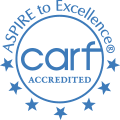At Mount Regis Center, we offer an intensive, evidence based approach to meth use disorder treatment. We offer a variety of therapeutic interventions that help our clients build a strong foundation for long-term recovery.
Understanding Meth
Learn about meth addiction and substance use disorder
Methamphetamines, a Schedule II drug, are a far more potent class of an amphetamine drug that are sometimes prescribed to treat narcolepsy and ADHD under the trade name Desoxyn. More commonly methamphetamine is a street drug that stimulates the usage of the central nervous system and the brain in a similar fashion to speed. Methamphetamines are available in two forms. As a white powdered crystal-like substance, and large crystal chunks, leading to the name “crystal meth.” Meth is also known by other names such as “chalk,” “crank,” “glass,” “tweak,” “crystal,” and, “tina.”
Meth can be taken orally, snorted, injected, or smoked, all producing various levels of a euphoric high, “rush,” and intense alertness. Snorting or orally ingesting meth creates a high without the rush. Smoking crystal meth, which is a purer form of the illegal drug, produces a very intense high and rush lasting between 4-12 hours. Following usage, methamphetamine is rapidly absorbed into the bloodstream and distributed to most parts of the body, including the central nervous symptom, producing effects similar to that of other stimulants, such as cocaine. Methamphetamine crosses the blood-brain barrier with greater ease that other stimulants, creating a longer-lasting high and, conversely, higher damage to the body, including damage to the brain and CNS. Methamphetamines are some of the most addictive substances in the world with many meth addicts stating that they have become addicted to the illegal substance after one usage.
Methamphetamine is a synthetic chemical that is commonly manufactured in illegal, makeshift laboratories using ordinary and inexpensive materials. The materials used to manufacture methamphetamines are highly dangerous. Meth lab cooks use derivatives from over-the-counter amphetamines such as pseudoephedrine and increases their potency by adding chemicals such as battery acid, drain cleaner, anhydrous ammonia, lantern fuel and antifreeze. Many meth cooks die in explosions in their meth labs. The production of one pound of methamphetamines creates five pounds of toxic waste.
Methamphetamines are extremely addictive in part because the drugs hyper-stimulate the pleasure pathways of the brain. When the drug is discontinued, many meth addicts begin to experience anhedonia, or the inability to feel pleasure, which can lead to relapse. This dangerous cycle is what leads many meth addicts to experience brain damage and damage to vital organs as their addiction progresses.
Statistics
Meth addiction statistics
Methamphetamine addiction is a growing problem in the United States and worldwide. The United Nations Office on Drugs and Crime estimated that each year, the worldwide production of amphetamine-like stimulants at nearly 500 metric tons each year, with over 24 methamphetamine abusers. In 2008, the US estimated that over 13 million individuals aged 12 and over have abused methamphetamine – 549,000 of these are regular abusers of methamphetamines. This number is increasing exponentially each year.
Causes and Risk Factors
Causes and risk factors for meth addiction
Addiction to methamphetamines is not caused by a single factor; researchers believe the addiction is a disease caused by many factors working together. Some of the most common causes include:
Genetics: Individuals who have a first-degree relative, such as a parent or sibling, who are addicted to a substance such as methamphetamines are at a higher risk for developing addictions later in life.
Biological: Certain individuals may be born with a defect in the pleasure/reward system of the brain, which can leave individuals being unable or under-able to feel pleasure. Meth has powerful effects on the pleasure center of the brain, which may be why certain individuals become addicted to meth.
Environmental: Individuals who grow up in chaotic home environments where addiction runs amok are at greater risk for developing addictions later in life. In addition, individuals who begin to abuse drugs at earlier ages are at a greater risk for addiction to more hardcore drugs.
Psychological: It’s been postulated that individuals who are suffering from addictions to substances such as methamphetamines are attempting to self-medicate the symptoms of an underlying mental illness.
Signs and Symptoms
Signs and symptoms of meth addiction
The symptoms of methamphetamine abuse and addiction will vary wildly according to the amount of methamphetamine abused and the route of abuse. Some of the most common symptoms of meth addiction include:
Mood symptoms:
- Euphoria
- Depression
- Anxiety
- Irritability
Behavioral symptoms:
- Increased self-esteem
- Financial difficulties
- Increased libido
- Hyperactivity
- Risky behaviors
- Increased attention
- Increased energy
- Increased self-confidence
- Social isolation
- Extreme amounts of talking – talking very quickly
- Legal problems
- Cracks in interpersonal relationships
- Preoccupation with obtaining, using, and recovering from meth use
- Violent behaviors
Physical symptoms:
- Decreased appetite
- Decreased need for sleep
- Emaciation
- Malnutrition
- Cardiovascular damage
- Dilated pupils
- Tachycardia followed by periods of bradycardia
- Cardiac arrhythmias
- Diarrhea
- Periods of hypertension followed by hypotension
- Acne
- Twitchiness
- Excessive sweating
- “Meth Mouth”
- Headaches
- Seizures
- Heart attack
- Stroke
Psychological symptoms:
- Dermatillomania – compulsive skin picking from the delusions of “crank bugs”
- Obsessive behaviors
- Paranoia
- Trichotillomania – compulsive hair pulling
- Psychomotor agitation
- Psychosis
- Hallucinations
- Delusions of grandiosity
- Extreme feelings of power and invincibility
- Suicide
Effects
Effects of meth addiction
The long-term effects of meth abuse are extremely dangerous as methamphetamines are a dangerous addiction. Common long-term effects of methamphetamine addiction include:
- Crumbling interpersonal relationships
- Incarceration
- Financial Ruin
- Bloodborne diseases if meth is used intravenously
- Homelessness
- Joblessness
- Depression
- Heart disease
- Addiction
- Memory loss
- Decreased ability to pay attention
- Damage to brain and CNS
- Liver damage
- Kidney damage
- Damage to all organ systems
- Decreased executive function of the brain
- Cognitive defects
- Increased risk for developing Parkinson’s disease
- Psychosis
- Violent behaviors
- Effects of risk-taking behaviors
- Suicide
Co-Occurring Disorders
Meth addiction & co-occurring disorders
Many individuals who are addicted to methamphetamines also suffer from co-occurring mental health disorders. Some of the most common co-occurring disorders include:
- Benzodiazepine abuse
- Alcoholism
- Bipolar disorder
- Anxiety disorders
- Schizophrenia
- Depressive disorders
- Antisocial personality disorder
- Conduct disorders
Withdrawal & Overdose
Effects of meth withdrawal and overdose
The effects of withdrawal from methamphetamines will vary according to the method of abuse, the length of time a person has been under the influence of methamphetamines and the amount of methamphetamines used. Common withdrawal symptoms from methamphetamines include:
- Exhaustion
- Strong drug cravings
- Increased appetite
- Anxiety
- Irritability
- Headaches
- Agitation
- Restlessness
- Suicidal ideation









